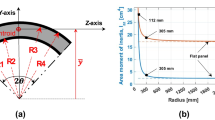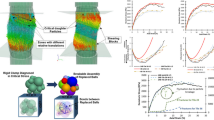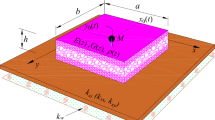This paper uses the Split Hopkinson Pressure Bar (SHPB) test to analyze the aluminum honeycomb’s dynamic and failure behavior under different strain rates. At the same time, we propose a modeling method. The representative volume element (RVE) models the complex materials. On this basis, the equivalent material parameters of complex materials are calculated. Taking the aluminum honeycomb material as an example, we use the equivalent material parameters calculated by the representative volume element of aluminum honeycomb to construct the macro-model of the aluminum honeycomb and compare it with the refined model of aluminum honeycomb. According to the SHPB test of aluminum honeycomb, the finite element models are compared and calibrated, and the accuracy of the finite element model is verified. It is expected to provide a reference for applying aluminum honeycomb materials in various fields, the dynamic behavior of aluminum honeycomb, and the combined use of multi-scale finite element modeling.











Similar content being viewed by others
References
S. D. Papka and S. Kyriakides, “In-plane compressive response and crushing of honeycomb,” J. Mech. Phys. Solids, 42, No.10, 1499-1532 (2015).
S. D. Papka and S. Kyriakides, “Experiments and full-scale numerical simulations of in-plane crushing of a honeycomb,” Acta Mater., 46, No.8, 2765-2776 (1998).
E. Wu and W. S. Jiang, “Axial crush of metallic honeycombs,” Int. J. Impact Eng., 19, No.5-6, 439-456(1997).
A. Wilbert, W. Y. Jang, S. Kyriakides, et al., “Buckling and progressive crushing of laterally loaded honeycomb,” Int. J. Solids Struct., 48, 5, 803-816 (2011).
S. Xu, J. H. Beynon, D. Ruan, et al., “Experimental study of the out-of-plane dynamic compression of hexagonal honeycombs,” Compos. Struct, 94, 8, 2326-2336 (2012).
M. Alkhader, W. Abuzaid, M. Elyoussef, et al., “Localized strain fields in honeycomb materials with convex and concaved cells,” Eur. J. Mech. A Solids - A/Solids, 80, 103890 (2019).
B. Li, Y. Wei, F. Meng, et al., “Atomistic simulations of vibration and damping in three-dimensional graphene honeycomb nanomechanical resonators,” Superlattices Microstruct., 139, Mar, 106420.1-106420.7 (2020).
X. E. Guo and L. J. Gibson, “Behavior of intact and damaged honeycombs: a finite element study,” Int. J. Mech. Sci., 41, 1, 85-105(1999).
D. H. Chen and S. Ozaki, “Analysis of in-plane elastic modulus for a hexagonal honeycomb core: Effect of core height and proposed analytical method,” Compos. Struct., 88, 1, 17-25 (2009).
A. Harkatia, D. Boutagougaa, E. Harkati, et al., “In-plane elastic constants of a new curved cell walls honeycomb concept – ScienceDirect,” Thin Wall. Struct., 149, 106613 (2019).
P. S. Farrugia, R. Gatt, S. D. Vrieze, et al., “Edge effects of a hexagonal honeycomb on the Poisson’s ratio and Young modulus,” Phys. Status Solidi (b), 257, 1900511.1- 1900511.15 (2020).
P. T. Wu, C. Q. Wu, Z. X. Liu, et al., “Numerical simulation of SHPB test of ultra-high performance fiber reinforced concrete with the meso-scale model” (in Chinese), Sci. Sin-Phys Mech. Astron., 50, 024614 (2020).
N. Jones, “Recent progress in the dynamic plastic behaviour of structures, Part Iv,” Shock Vib., 10, No. 9, 21-33 (1985).
R. Wang and C. Q. Ru, “An energy criterion for the dynamic plastic buckling of circular cylinders under impulsive loading,” Metal Forming and Impact Mechanics, 213-223 (1985).
W. Abramowicz and N. Jones, “Dynamic axial crushing of square tubes,” Int. J. Impact Eng., 2, No. 2, 179-208 (1984).
W. Abramowicz and N. Jones. “Dynamic axial crushing of circular tubes,” Int. J. Impact Eng., 2, No. 3, 263-281 (1984).
W. Abramowicz, “Dynamic progressive buckling of circular and square tubes,” Int. J. Impact Eng., 4, No. 4, 243–270 (1986).
J. J. Harrigan, S. R. Reid, and C. Peng, “Inertia effects in impact energy absorbing materials and structures,” Int. J. Impact Eng., 22, 9/10, 955-979 (1999).
S. T. Hong, J. Pan, T. Tyan, et al., “Dynamic crush behaviors of aluminum honeycomb specimens under compression dominant inclined loads,” Int. J. Plast., 24, No. 1, 89-117 (2008).
S. L. Omairey, P. D. Dunning, and S. Srinivas, “Development of an ABAQUS plug-in tool for periodic RVE homogenization,” Eng. Comput., 35, No. 2, 567-577(2019).
D. K. Francis, W. R. Whittington, Lawrimore, et al., “Split Hopkinson pressure bar graphical analysis tool,” Exp. Mech., 57, 179–183 (2017).
Acknowledgment
This work was supported by the National Key R&D Program (2017YFC0703605) and the Key R&D Program of the Shandong Province of China (2018GSF117029).
Author information
Authors and Affiliations
Corresponding author
Additional information
Translated from Problemy Mitsnosti, No. 1, p. 7, January – February, 2022.
Rights and permissions
About this article
Cite this article
Yang, R., Zhang, J.G., Liang, H.Z. et al. Split Hopkinson Pressure Bar (SHPB) Test and Different Modeling Methods of Aluminum Honeycomb Materials. Strength Mater 54, 33–40 (2022). https://doi.org/10.1007/s11223-022-00375-6
Received:
Published:
Issue Date:
DOI: https://doi.org/10.1007/s11223-022-00375-6




